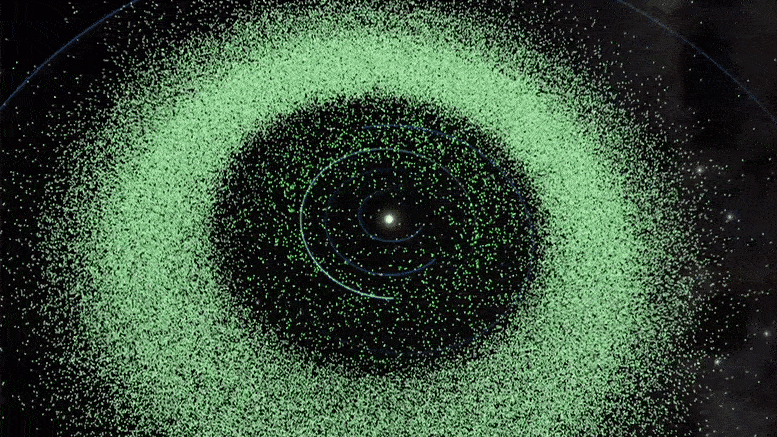

There are a lot of asteroids to track in our solar system and many are yet to be discovered.
Cloud-Based Astrodynamics Platform To Discover and Track Asteroids
Discovering and tracking asteroids is critical for planetary defense against killer asteroid impacts. The detailed astronomical data associated with it is also useful for providing new insights for astronomers. Helping with this task is a new algorithm called THOR, which has now proven to be capable of finding asteroids. It has been running on the Asteroid Institute’s cloud-based astrodynamics platform for identifying and tracking asteroids.

Visualizing the trajectories through the solar system of asteroids discovered by ADAM and THOR. Credit: B612 Asteroid Institute/University of Washington DiRAC Institute/OpenSpace Project
A novel algorithm developed by University of Washington researchers to discover asteroids in the solar system has proved its mettle. The first candidate asteroids identified by the algorithm — known as Tracklet-less Heliocentric Orbit Recovery, or THOR — have been confirmed by the International Astronomical Union’s Minor Planet Center.
The Asteroid Institute, a program of B612 Foundation, has been running THOR on its cloud-based astrodynamics platform — Asteroid Discovery Analysis and Mapping, or ADAM — to identify and track asteroids. With confirmation of these new asteroids by the Minor Planet Center and their addition to its registry, researchers using the Asteroid Institute’s resources can submit thousands of additional new discoveries.
“A comprehensive map of the solar system gives astronomers critical insights both for science and planetary defense,” said Matthew Holman, dynamicist and search algorithm expert at the Center for Astrophysics | Harvard & Smithsonian and the former director of the Minor Planet Center. “Tracklet-less algorithms such as THOR greatly expand the kinds of datasets astronomers can use in building such a map.”
THOR was co-created by Mario Jurić, a UW associate professor of astronomy and director of the UW’s DiRAC Institute, and Joachim Moeyens, a UW graduate student in astronomy. They and their UW collaborators unveiled THOR in a paper published last year in The Astronomical Journal. It links points of light in different sky images that are consistent with asteroid orbits. Unlike current state-of-the-art codes, THOR does not require the telescope to observe the sky in a particular pattern for asteroids to be discoverable.
Asteroid Institute ADAM STK Visualization
The Asteroid Institute’s ADAM platform is an open-source computational system that runs astrodynamics algorithms at large scale using Google Cloud, in particular the scalable computational and storage capabilities in Google Compute Engine, Google Cloud Storage and Google Kubernetes Engine.
“The work of the Asteroid Institute is critical because astronomers are reaching the limits of what’s discoverable with current techniques and telescopes,” said Jurić, who is also a senior data science fellow with the UW eScience Institute. “Our team is pleased to work alongside the Asteroid Institute to enable mapping of the solar system using Google Cloud.”
Asteroid orbits.
Researchers can now begin systematic explorations of large datasets that were previously not usable for discovering asteroids. THOR recognizes asteroids and, most importantly, calculates their orbits well enough to be recognized by the Minor Planet Center as tracked asteroids.
Moeyens searched a 30-day window of images from the NOIRLab Source Catalog, a collection of nearly 68 billion observations taken by the National Optical Astronomy Observatory telescopes between 2012 and 2019, and submitted a small initial subset of discoveries to the Minor Planet Center for official recognition and validation. Now that the computational discovery technique has been validated, thousands of new discoveries from the catalog and other datasets are expected to follow.
Asteroids in our solar system.
“Discovering and tracking asteroids is crucial to understanding our solar system, enabling development of space and protecting our planet from asteroid impacts,” said Ed Lu, executive director of the Asteroid Institute. “With THOR running on ADAM, any telescope with an archive can now become an asteroid search telescope. We are using the power of massive computation to enable not only more discoveries from existing telescopes, but also to find and track asteroids in historical images of the sky that had gone previously unnoticed because they were never intended for asteroid searches.”
Reference: “THOR: An Algorithm for Cadence-independent Asteroid Discovery” by Joachim Moeyens, Mario Jurić, Jes Ford, Dino Bektešević, Andrew J. Connolly, Siegfried Eggl, Željko Ivezić, R. Lynne Jones, J. Bryce Kalmbach and Hayden Smotherman, 15 September 2021, The Astronomical Journal.
DOI: 10.3847/1538-3881/ac042b
The B612 Foundation recently announced an additional $2.3 million in leadership gifts to advance these efforts.
The collaborative efforts of Google Cloud, B612’s Asteroid Institute, and the University of Washington’s DiRAC Institute make this work possible.